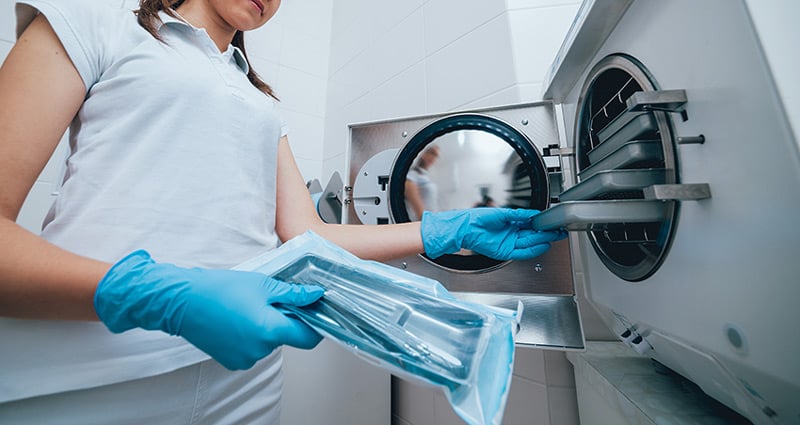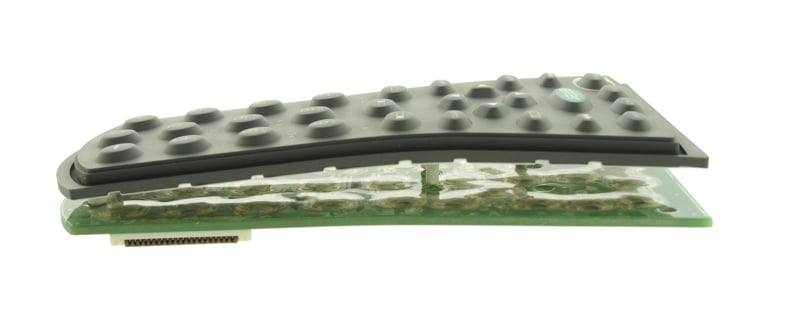Specific to medical devices, handheld electronics, rack-mounted equipment, and other instrumentation utilize membrane switches as a low-cost and high-reliability solution for keypad and button technologies. There are countless button and switch options available for the plethora of design requirements that exist. Medical professionals use these buttons as the primary way to interface and operate the device.
These keypad and membrane switch assemblies require extensive testing to make certain they can operate across a wide range of operating conditions and temperature ranges. These conditions include extreme temperatures, sterilization procedures, and the robust demands of everyday use. These products must also be screened to demonstrate they do not cause unwanted electro-magnetic interference to other equipment in the room. Not all keypad and membrane switch designs will survive the tough conditions medical devices face on a day-to-day basis.
Because of the nature of the operating and exam rooms, frequent aggressive cleaning procedures are standard on all equipment to safeguard patients and workers. But one of the harshest and most frequently performed sterilization processes is also one of the most difficult to design for. An autoclave reaches temperatures of 121°C at varying pressures. Autoclaves are typically what is available in hospitals for reprocessing reusable instruments, with widespread use across many industries. Dentists, hospitals, and even veterinarians use autoclave sterilization because of its practicality.

An autoclave reaches temperatures of 121°C at varying pressures.
Why Use an Autoclave?
Autoclaves use steam and heat to sterilize various types of products in numerous industries. Medical grade autoclaves can be tabletop sized, or the size of a washing machine depending. Autoclaves must reach temperatures of 121°C for prolonged periods of time. This temperature is held for a predetermined length of time based on the application, sometimes up to 60 minutes. Autoclaves must draw vacuum on the chamber first or apply heat with pressure to achieve the desired sterilization results. Some sterilization cycles can be executed with chemicals such as ethylene oxide offering varying types of cleaning results. By applying heat and pressure using steam, autoclaves destroy harmful pathogens, viruses, and bacteria allowing for medical products to be safely reused.
Most products that are placed within the autoclave are instruments made of stainless steel and other types of metal. Normally, periodontal probe sets and dental instruments that require sterilization are packed in trays for the autoclave process. Other medical devices are wrapped and placed in the different packaging arrangements to complete the required sterilization procedures. While most products used in autoclaves are made of metal, some applications allow higher complexity assemblies and even electronic devices to be used within autoclaves. When designed accordingly, small circuit boards assemblies and rubber keypad products can qualify for the conditions of an autoclave.
Membrane Switch Design Options for Use in Autoclaves
The sizing factor for designing around an autoclave is the temperature requirement of 121°C. Products must survive a short-term exposure to 121°C and operate after being baked in this environment for up to one hour. Electronic components should be sized accordingly and selected with that limitation in mind. Some PCBA components can be sourced to survive high temperatures in excess of 121°C, allowing for their use in these design applications. Discrete components like capacitors and resistors are usually rated for an operating temperature of -55°C ~ 125°C, or even higher, allowing for their use in many autoclave applications. ICs and EEPROMs may be damaged by the conditions of an autoclave and should be specified carefully. Other materials such as graphic overlays and sheet adhesives can break down at high temperatures, creating issues during development and forcing engineers to consider alternate design options.

Layers of a rubber keypad membrane switch.
Traditional membrane switches contain various types of polycarbonate and polyester films. These layers of film include the dome retainer, spacer layers, and the outer most layers that show graphics or artwork. Also known as graphical overlays, these surfaces are usually manufactured from hard-coated polycarbonate or polyester and should be avoided in autoclave applications since many of the products are rated for 85°C or lower. While these films won’t melt per se after short-term exposure to an autoclave at 121°C, the films can delaminate, become brittle and crack, or become discolored. Higher-temperature materials must be used throughout the assembly in order to survive repeated exposure to an autoclave.
Silicone elastomer is an exceptional material for medical applications and is widely used for keypads on various types of medical devices. Medical grade silicone jacketed cables are used where high temperatures and strict sterilization requirements exist. Since most silicone elastomers are rated for temperatures of 200°C or more, they are more than suitable for exposure to the superheated steam of an autoclave.
Standard grade adhesives are rated for 85°C or lower, forcing designers to use high-performance adhesives and transfer tapes to survive the autoclave sterilization cycle. With the multitude of adhesive types available for designers, it’s critical to choose options that are safe to use in a hospital and can survive exposure to the temperature and pressurization cycles of an autoclave. Specialty adhesives are designed for high/low-temperature cycling and exposure to humidity, but these can come with long lead times, high minimum order quantities, and sometimes are not available in the roll or sheet form you may need.
Testing is critical to make certain that the eventual solution is proven to work in the conditions required.
Getting Started
If your objective is to design an electronic device capable of surviving countless autoclave sterilization cycles, it’s vital to choose a base circuit material that can handle the high temperatures.
Traditional screened-on silver ink may become unstable if the PET layer cannot handle the high temperatures. Flexible polyimide circuits can be considered because of polyimide’s resilience to temperature extremes. Some membrane switches are only buttons and LEDs, with no active components or logic on the circuit board. Other types of membrane switch designs can be paired with non-volatile memory and microcontrollers to carry out simple commands. Surface mounted components must be chosen based on both their operating and storage temperature ratings.
Summary
Silicone rubber is a solid choice as the overlay material for autoclave applications. Where possible, standard grade adhesives should be avoided. Assembling using mechanical fasteners instead of adhesive can help mitigate the impacts of high-temperature exposure, especially on adhesives, but this is not always feasible. As with any complex system, large swings in temperature, exposure to steam, and thermal expansion cycles can break down high performance adhesives and other materials making them vulnerable to premature failure. As is true for any new development project, testing is required to make certain that the membrane switch operates before and after exposure to the autoclave sterilization process.
Early engagement with a full-service manufacturing partner such as Epec helps review these design activities early and reduce the time to market for complex medical devices requiring autoclave sterilization.
Key Takeaways
- Autoclave sterilization is demanding: Devices must withstand 121°C steam and pressure for up to an hour, making material and component selection critical for survival and long-term reliability.
- Traditional films fall short: Standard polycarbonate and polyester films used in overlays and spacer layers degrade under autoclave conditions, leading to brittleness, discoloration, and delamination.
- Silicone elastomer excels in harsh environments: Medical-grade silicone, rated for 200°C or more, is a durable choice for overlays and keypads exposed to repeated sterilization cycles.
- Adhesives are a weak link: Standard adhesives often fail above 85°C, requiring high-performance alternatives or even mechanical fastening to maintain integrity under heat, steam, and pressure.
- High-temperature circuit materials are essential: Polyimide-based flexible circuits and carefully selected surface-mount components ensure the switch assembly can handle repeated autoclave cycles without functional degradation.
















